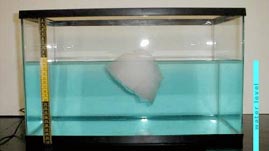Teachers' Domain - Digital Media for the Classroom and Professional Development
User: Preview

Source: Texas A&M University: Ocean Drilling Distance Learning Program



This interactive activity adapted from Texas A&M University simulates how the melting of ice shelves and ice sheets affects sea level. In one video, observe a block of ice melt while it floats in the tank, simulating an ice shelf; the water level does not change. In a second video, see a block of ice melt as it rests on a plank of wood above the water, simulating an ice sheet; the water level rises.
Ice becomes liquid water when warmed to its melting point. Conversely, liquid water changes state to become ice when cooled to its freezing point. Earth's polar regions consist largely of ice, and exhibit dramatic changes in ice coverage in response to seasonal changes in temperature. An increase in temperature resulting from global warming could drastically affect the extent of polar ice. Whether those changes would cause sea level to rise depends on whether the ice is continental ice or floating ice.
Continental ice (such as glaciers and ice sheets) raises sea level as it melts. This happens because when ice on land melts, it adds water into the ocean that was not there before. This extra water raises sea level. For example, if the West Antarctic ice sheet melted, sea level would rise by at least 5 meters. That is a significant amount; even a rise of just one meter would displace roughly 100 million people along coastlines.
Floating ice (such as ice shelves, icebergs, and sea ice) would not have much effect on sea level. According to a physical concept known as Archimedes' principle, a floating object displaces an amount of water equal to its weight. In other words, floating ice displaces a volume of water approximately equal to the volume of water it would contribute as it melts; therefore, when floating ice melts, there is very little change in sea level.
However, although the melting of floating ice doesn't significantly affect sea level, there are other consequences. Variations in salinity and temperature drive global ocean circulation because of density differences; fresh water is less dense than salt water and warm water is less dense than cold water. This thermohaline circulation is sometimes referred to as the great ocean "conveyor belt" because it is one of Earth's main mechanisms for transporting energy. The formation of sea ice, which is primarily made of pure water, leaves behind salt in the water beneath the ice, resulting in saltier and colder water that sinks through the water below it, thereby promoting circulation. When ice melts, it adds fresh water to the ocean, decreasing salinity and affecting the circulation pattern. Any change to ocean circulation could have damaging effects on the water cycle and weather patterns.
In addition, a change in the temperature or salinity of ocean water disrupts habitats and could have harmful effects on marine life forms that are sensitive to such changes. The loss of sea ice in polar regions also threatens the survival of certain species, such as the polar bear, which depend on the ice for hunting and breeding. Furthermore, ice shelves act as buttresses, keeping glacial ice from reaching the ocean. Even if melting ice shelves would not increase sea level directly, the barrier that prevents ice sheets from sliding into the water would be gone, and the melting ice sheets would increase sea level.
 Loading Standards
Loading Standards Teachers' Domain is proud to be a Pathways portal to the National Science Digital Library.
Teachers' Domain is proud to be a Pathways portal to the National Science Digital Library.
